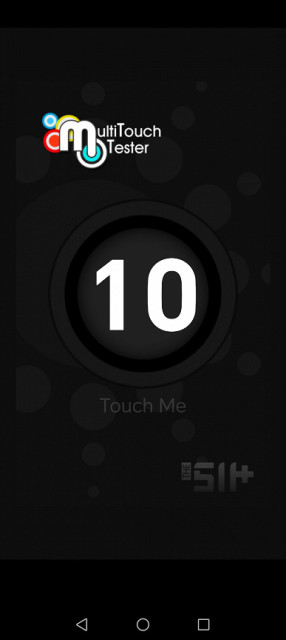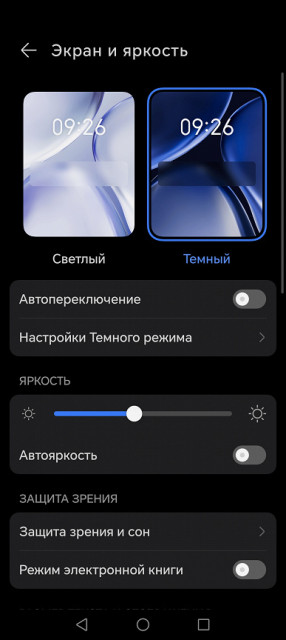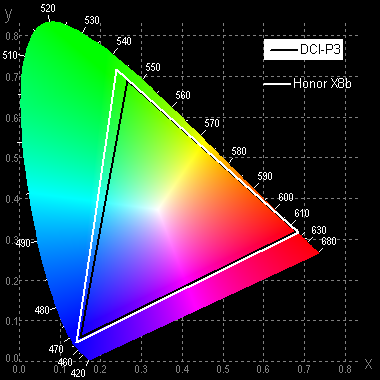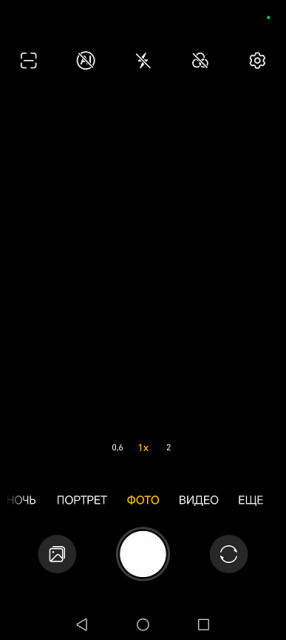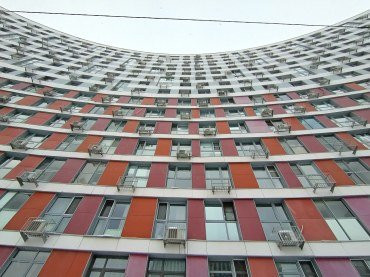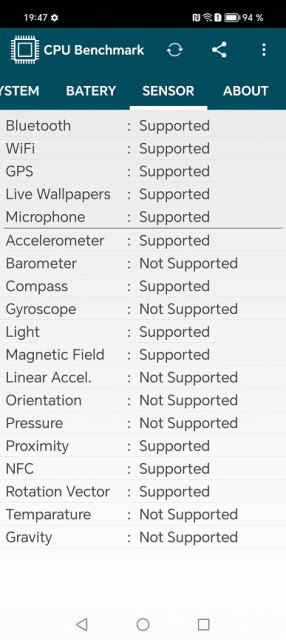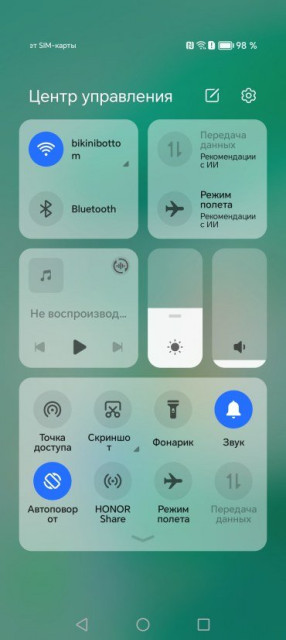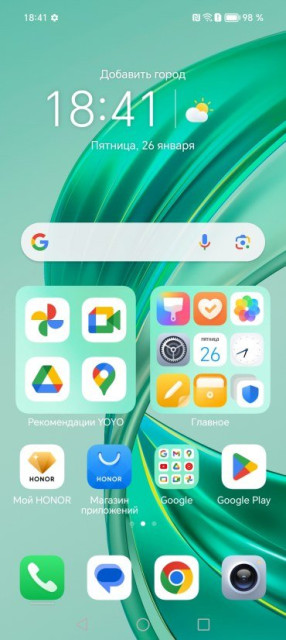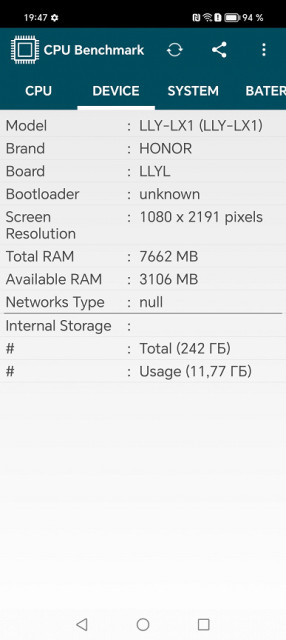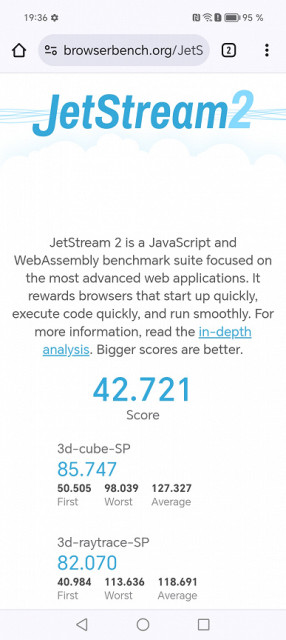Main characteristics of Honor X8b (model LLY-LX1)
- SoC Qualcomm SM6225 Snapdragon 680 4G, 8 processor cores (4×Cortex-A73 @2.4 GHz + 4×Cortex-A53 @1.9 GHz)
- GPU Adreno 610
- Operating system Android 13, MagicOS 7.2
- Touch display AMOLED, 6.7″, 1080×2412, 90 Hz, 20:9, 394 ppi
- RAM 8 GB, internal memory 128/256/512 GB
- No microSD support
- Nano-SIM support (2 pcs.)
- Networks 2G GSM, 3G WCDMA, 4G
- GPS, Glonass, Galileo, BDS
- Wi-Fi 5 (2.4/5 GHz)
- Bluetooth 5.0, A2DP, LE
- NFC
- USB 3.0 Type-C, USB OTG
- There is no 3.5mm audio output for headphones
- Cameras 108 MP + 5 MP (wide-angle) + 2 MP, video 1080p@30 fps
50 MP front camera with flash - Proximity and lighting sensors, magnetic field, accelerometer
- Fingerprint scanner (side-mounted)
- Battery 4500 mAh, charging 35 W
- Dimensions 161×75×6.8 mm
- Weight 166 g
Appearance and ease of use
The Honor X8b smartphone comes in a cardboard box with a stylish, laconic, pleasant-looking design.
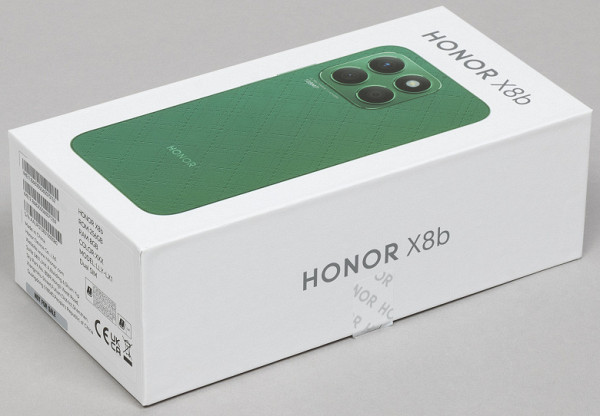
The smartphone comes with a charger with a maximum output power of 35 W, a connection cable and a protective case.

The Honor X8b smartphone is made in a modern, contemporary design, where there is no place for narrowed sides and sloping edges. Here all the panels are flat, and the sides are smooth and wide. Such a case is perfectly held in the hand, without digging into the skin of the palm at the same time.
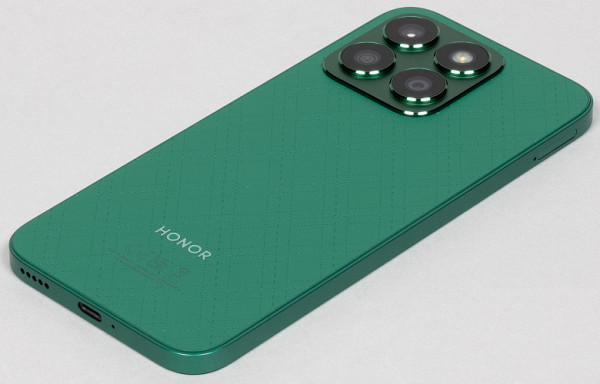
The smartphone looks stylish, neat and elegant, giving the impression of a more expensive device. It is difficult to determine its price category based on its appearance, since the device can easily fit into various image styles. It's important to note that the materials used, despite not having premium features, contribute to the overall feel of the device. For example, the side frame is made of plastic rather than metal. The back panel can be made of hard matte rough plastic or, in the case of the green version, eco-leather. This material is not susceptible to visible fingerprint marks and provides a secure grip on your hands.
In terms of dimensions, the device is not that big; in its price category, it is perhaps one of the thinnest and lightest smartphones. The weight of 166 grams is quite surprising by today’s standards.

The included silicone case is transparent and flexible. It is thick and reliable, covering the block with cameras with protrusions.
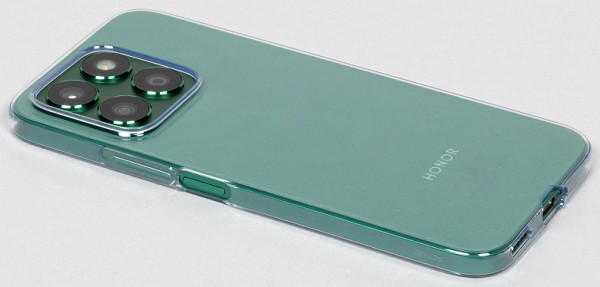
The rear cameras are designed in the style of “burners”. Four identical-sized round glasses hide three cameras and a flash. It looks as neat and stylish as possible.
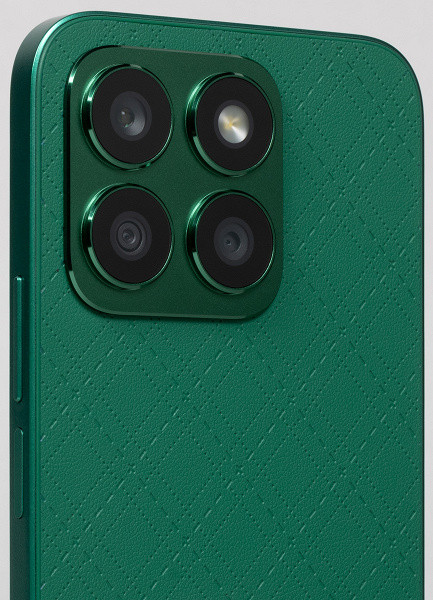
The side buttons are conveniently located on one side, the keys are wide and easy to touch. The fingerprint scanner is built into the power button and works flawlessly.

The front camera is single, it is installed together with an LED flash behind an oval cutout in the screen matrix at the top center.
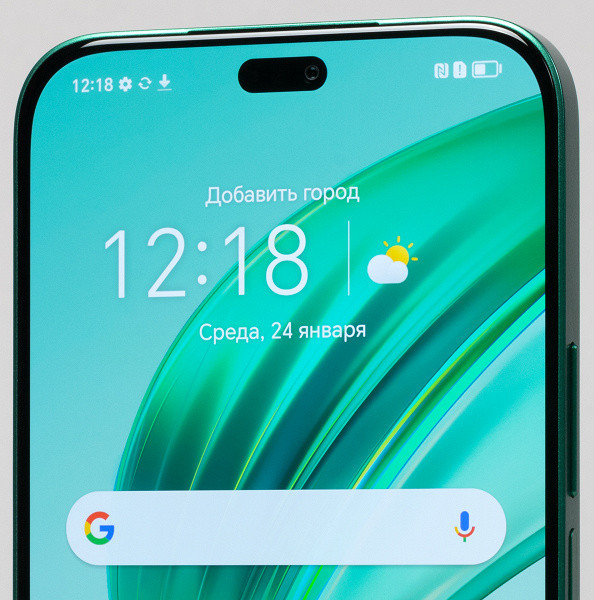
The dual tray can accommodate two Nano-SIM cards. But a microSD memory card cannot be installed at all.
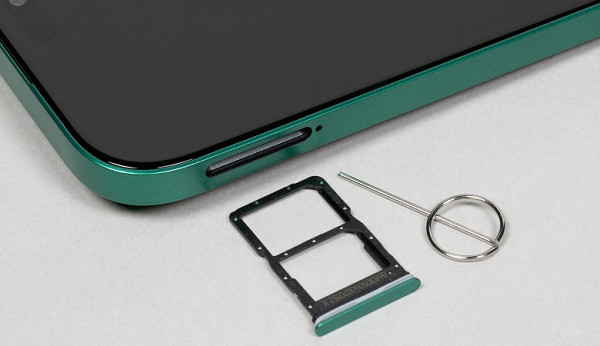
At the bottom end there is a speaker, a microphone and a USB Type-C connector. There is no 3.5mm audio output for a wired headset.

There is nothing on the top end except the hole for an additional microphone.

The Honor X8b smartphone does not receive full protection from moisture and dust. The model is available in black, white or green.
Screen
The Honor X8b smartphone is equipped with a 6.7-inch AMOLED display with a resolution of 1080x2412 pixels and an aspect ratio of 20:9. The screen has a flat protective glass and pronounced curved corners. Physical dimensions are 70x156 mm, pixel density reaches 394 ppi. The width of the frames around the screen is 2 mm on the sides and top, and 3 mm on the bottom. The screen supports a 90Hz refresh rate for smoother content display.
The front surface of the screen is made in the form of a mirror-smooth glass plate that is scratch-resistant. The screen's anti-glare properties are superior to those of the Nexus 7, making it more readable in bright light. Oleophobic coating on the outer surface improves fingerprint resistance.
The maximum screen brightness under normal conditions is 550 cd/m², and in strong sunlight using automatic adjustment it can reach 1120 cd/m². The screen provides excellent readability during the day in the sun, thanks to its high brightness and good anti-glare properties. The minimum brightness is 2 cd/m², which allows you to use the device in complete darkness.
Brightness adjustment is automatically carried out by a light sensor. In complete darkness, the brightness is reduced to 4 cd/m², in office conditions it is set to 160 cd/m², and in bright sunlight it reaches 1120 cd/m². The auto-brightness feature allows users to customize their screen experience based on lighting conditions.
At high and medium brightness levels, modulation with a frequency of approximately 60 or 90 Hz may be observed.
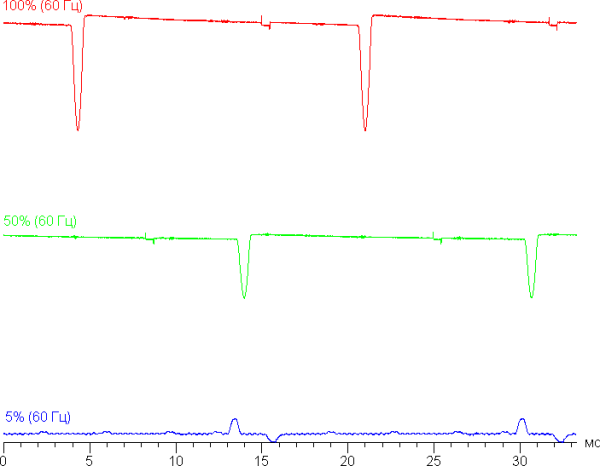
At high and medium brightness levels, a low modulation frequency (60 Hz) is observed, but it is accompanied by a low duty cycle, which eliminates visible flicker. With a significant decrease in brightness, modulation occurs with a more complex character, but despite the presence of a peak with a frequency of about 3240 Hz, no visible flicker is observed.
In the screen settings there is an option for an increased refresh rate of up to 90 Hz:
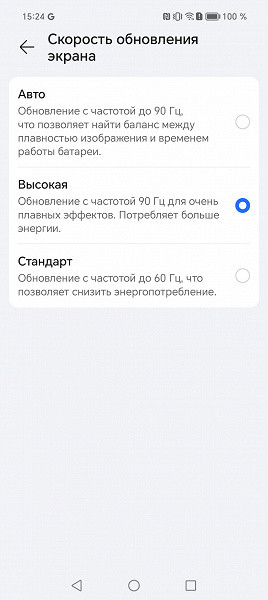
In these modes, the smoothness of scrolling (lists in menus, etc.) is noticeably improved. Let's see if this changes the nature of the modulation. 90Hz mode:
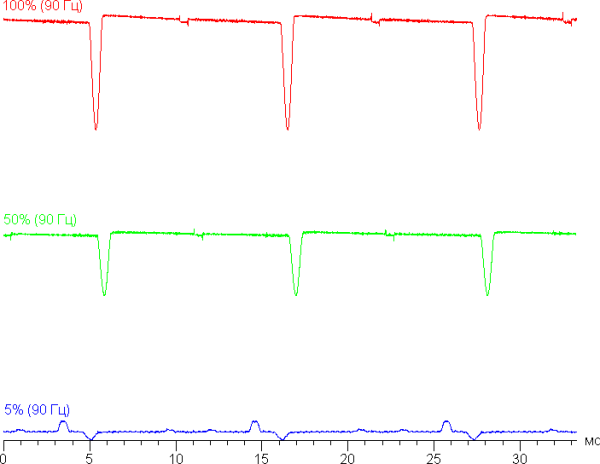
At high and medium brightness levels, an increase in the modulation frequency by a factor of 1.5 is observed, while at low brightness the modulation pattern remains unchanged. However, no visible flicker was noticed.
This screen uses AMOLED technology — active matrix organic light-emitting diodes. A full-color image is formed using subpixels of three colors: red ®, green (G) and blue (B), with the number of red and blue subpixels being half as many, forming an RGBG structure. This is confirmed by a fragment of a microphotograph:
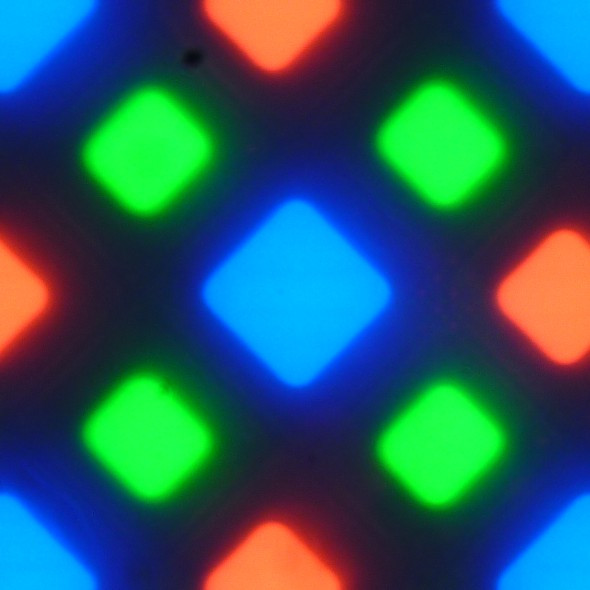
In the image fragment above, you can count 4 green subpixels, 2 red (4 halves) and 2 blue (1 whole and 4 quarters), and by repeating these fragments you can fill the entire screen without gaps or overlaps. For such matrices, Samsung uses the term PenTile RGBG. The manufacturer calculates screen resolution based on green subpixels, and it will be lower based on the other two. Some artifacts, such as jagged contrast edges, may occur, but due to the high resolution these have minimal impact on image quality.
The screen has excellent viewing angles. Even at significant deviation angles, the white color practically does not change shade, which is not so common in OLED technology. Blacks remain true blacks from all viewing angles. It is so saturated that the contrast parameter is not applicable in this case. For clarity, photographs are shown in which the images of the smartphone and the device being compared display the same images. The brightness of the screens is initially set to approximately 200 cd/m², and the color balance on the camera is artificially set to 6500 K.
Example of a white field (Vivid colors profile):
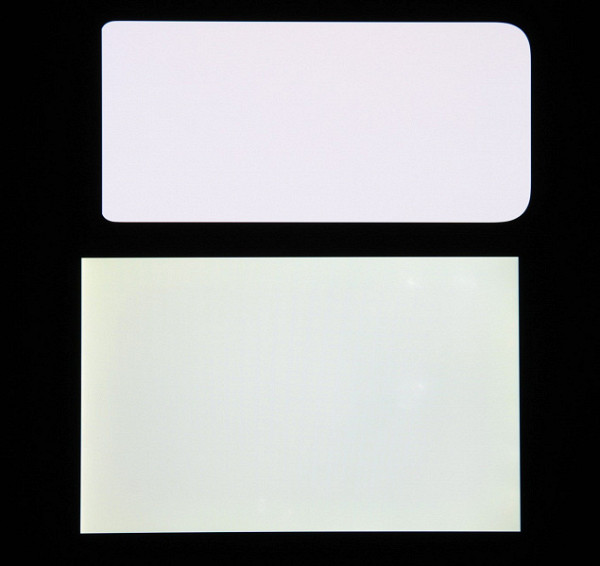
Note the good uniformity of brightness and color tone of the white field.
And a test picture (profile Normal [colors]):

Color reproduction on both screens is good, colors are moderately saturated, but color balance is slightly different. It is important to note that a photograph cannot be an absolutely accurate source for assessing the quality of color rendering and is provided solely for illustrative purposes. For example, the pronounced reddish tint in white and gray areas that is present in photographs of a smartphone screen is not visually perceptible to normal eyes, as confirmed by hardware tests using a spectrophotometer. This is explained by the fact that the spectral sensitivity of the camera matrix does not fully correspond to the characteristics of human vision.
The photo above was taken with the «Normal Colors» profile activated in the screen settings, and there are only two profiles available:
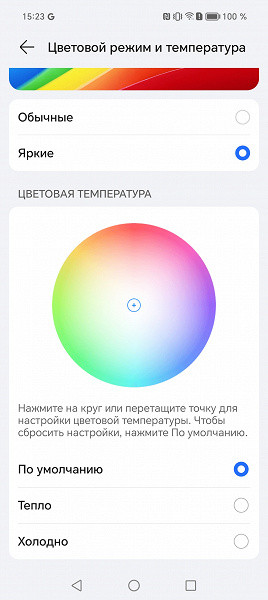
The Vivid [colors] profile (selected by default) has color balance and increased color saturation:

Both screens show a decrease in brightness at an angle, but the smartphone screen shows a weaker drop in brightness at an angle. Thus, even with the same formal brightness, this smartphone appears visually brighter compared to LCD screens, especially when viewed from a shallow angle.
Switching the state of the matrix elements occurs almost instantly, but when turned on, a step with a width of about 17 ms (corresponding to a screen refresh rate of about 60 Hz) or about 11 ms (90 Hz) can be observed. For example, this is what the dependence of brightness on time looks like when moving from black to white:
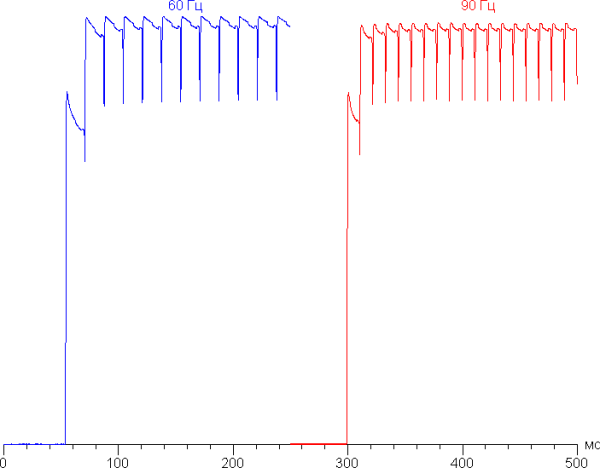
In some situations, the presence of the specified step can cause the effect of “trails” that follow moving objects.
The gamma curve, constructed using 32 points with equal intervals based on the numerical value of the gray shade, demonstrates the absence of a significant rollover in either light or dark areas. The exponent of the approximating power function is 2.21, which is close to the standard value of 2.2. The actual gamma curve deviates only slightly from the power law:

Let us recall that OLED screens are characterized by dynamic brightness adjustment for light areas of the image. This may affect the gamma curve since the measurements were taken with sequential grayscale output across almost the entire screen.
The color gamut in the Vivid profile covers a wide range, exceeding even DCI-P3, while in the Normal profile it is close to sRGB:
Without correction (the Bright option), the spectra of the components (that is, the spectra of pure red, green and blue colors) are very well separated:
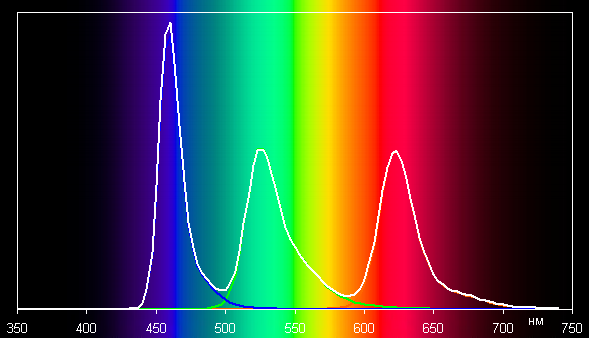
In the case of a profile, the usual color components are mixed with each other to a large extent:
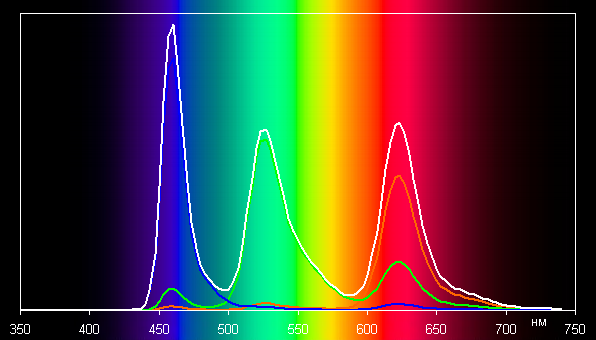
Note that on screens with a wide color gamut (without appropriate correction), the colors of regular images optimized for sRGB devices appear unnaturally saturated. Therefore, it is recommended to use the «Normal» profile when viewing movies, photos and other natural images.
The device provides the ability to correct color balance using a color temperature profile or adjusting hue on the color wheel. Even without adjustments in the Normal profile, the gray scale balance is good, as the color temperature is close to the standard 6500 K, and the error relative to the blackbody spectrum (ΔE) remains below 10 units, which is considered acceptable for a consumer device. At the same time, color temperature and ΔE change little from hue to hue, which has a positive effect on the visual assessment of color balance. (Dark areas of the gray scale can be ignored, since color balance is less important there, and the error in measuring color characteristics at low brightness can be large.)
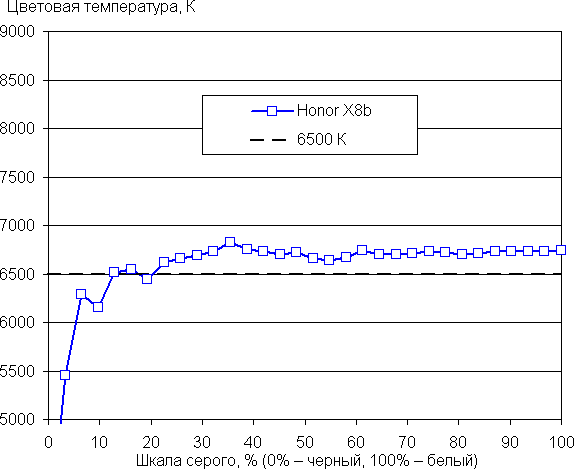
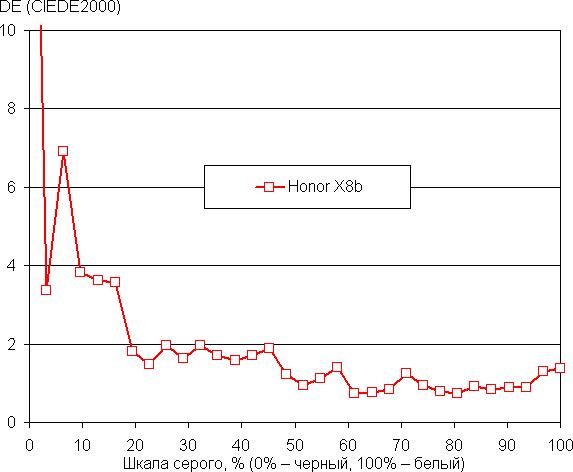
Of course, there is a function to reduce the intensity of the blue component:

The screen description conveys the information very accurately. Although bright light can disrupt the circadian rhythm, adjusting the brightness to a comfortable level without distorting the color balance is an acceptable solution. This unit probably does not support DisplayPort Alt Mode for USB Type-C, which means it is not possible to output image and sound to an external device via the USB port.
The conclusions are as follows: the screen has a high maximum brightness (1120 cd/m²) and excellent anti-glare properties, which allows you to use the device outdoors even on a sunny day. Brightness adjustment to a comfortable level in complete darkness is also possible (up to 2 cd/m²). It is recommended to use the mode with automatic brightness adjustment, which works adequately (with the exception of some features). The screen has an effective oleophobic coating, no visible flicker, support for a high refresh rate mode (90 Hz), as well as a color gamut close to sRGB and good color balance (if you select the appropriate profile). The general advantages of OLED screens, such as true blacks and less brightness drop when viewed from an angle, are also clearly evident. Overall, the screen quality is rated as very high.
Camera
At the back, the Honor X8b has three cameras — the main one, an ultra-wide-angle one, and a module for macro photography.
- 108 MP, 1/1.67″, f/1.8, PDAF (main)
- 5 MP, f/2.2 (ultrawide)
- 2 MP, f/2.4 (macro)
The main camera, equipped with a Samsung Isocell HM6 sensor, has an effective fast phase detection autofocus system, but is not equipped with an optical stabilizer. It's possible to shoot in both pixel binning and full resolution modes, but the camera's level of detail leaves much to be desired. Therefore, switching to full-size shooting mode may not be practical, and it is recommended to use the default 12MP mode.
The camera leaves much to be desired in terms of both detail and sharpness, especially around the edges of the frame where quality drops noticeably. Image softness is noticeable and photos often appear blurry. However, volumetric reproduction is quite well expressed, and the dynamic range copes with the transmission of detail in bright and dark areas of the scene, avoiding overexposure. Overall, the quality of the photos is rated below average. Here are more examples of shooting in automatic mode: [examples of shooting in auto mode].
At night, detail becomes even lower, and noise becomes visible.
Example of night shooting:

2x digital zoom works very well, using the central part of the image at a higher resolution.
The maximum possible digital zoom here is 8×.

The wide-angle module with a sensor of only 5 megapixels copes well with its task: there are certainly fewer details, but the image is not faded or dark, it is quite contrasty, and blurring at the edges is minimal for such a focal length.
The third camera — for macro photography — with its low sensor resolution is nothing interesting.
The front camera gives the user the option to choose between two «focal lengths», although the second option is actually just cropping the image to a wider viewing angle. Overall image quality is average, with textures lacking detail, dark areas poorly rendered, and backgrounds often a blurry mixture of colors. At the same time, the portraits come out quite decent.
The smartphone can shoot video at a maximum resolution of 1920×1080 at 30 frames per second without stabilization. The image is loose in detail, but there are no problems with sharpness and clarity. Color rendition is natural, white balance is not affected. The sound is recorded quite well.
Telephone and communications
The Honor X8b smartphone provides support for mobile networks up to 4G, ensuring reliable operation in wireless networks in the urban area of the Moscow region. The device demonstrates stable communication and quick restoration of the connection after a break.
The smartphone also has a wireless adapter that supports Wi-Fi 5 (802.11a/b/g/n/ac, 2.4/5 GHz) and Bluetooth 5.0, as well as NFC support.
The built-in single-channel satellite navigation module is compatible with GPS, Glonass, Galileo and BDS. A quick search for the first satellites during a cold start and high positioning accuracy leave no complaints.
The voice of the interlocutor sounds loud and clear in the speaker. Medium power vibration motor. According to the test conducted, the device does not seem to be equipped with a gyroscope, but it is equipped with all the necessary built-in sensors.
Software and multimedia
Honor X8b uses the Android 13 operating system with a custom MagicOS 7.2 shell. There are a limited number of apps pre-installed and available for download, including useful tools such as System Manager and the Honor App Store. No pop-up ads. The upper curtain is divided depending on the angle of retraction. Users have official access to the Google store and applications.
The smartphone is not equipped with stereo speakers. The single monaural speaker produces high-volume, rich sound. The wireless headphones feature Histen sound enhancement technology with various preset settings. It is important to note that the device does not have the classic 3.5 mm audio output for wired headphones.
Performance
Honor X8b is equipped with an octa-core Qualcomm SM6225 Snapdragon 680 4G processor, which runs on 6 nm architecture. The graphics subsystem is represented by the Adreno 610 GPU. The smartphone has 8 GB of LPDDR4X RAM. The internal storage can be selected with a capacity of 128, 256 or 512 GB using UFS 2.2 technology. It is important to note that you cannot insert a memory card into the device. There is also support for connecting external devices via the USB Type-C port in USB OTG mode.
This hardware platform was introduced in 2021 and is aimed at the segment of low- and mid-range budget devices. The performance of the SoC is sufficient for the smooth operation of the operating system and the launch of not too resource-intensive games. For example, popular games such as PUBG Mobile (medium settings) and Call of Duty: Mobile (low graphics settings) show a stable 59-60 frames per second.
Testing in comprehensive tests AnTuTu and GeekBench:
For convenience, we have compiled all the results we obtained when testing the smartphone in the latest versions of popular benchmarks into tables. The table usually adds several other devices from different segments, also tested on similar latest versions of benchmarks (this is done only for a visual assessment of the obtained dry figures). Unfortunately, within the framework of one comparison it is impossible to present the results from different versions of benchmarks, so many worthy and relevant models remain “behind the scenes” — due to the fact that they once passed the “obstacle course” on previous versions of test programs.
| Honor X8b (Qualcomm Snapdragon 680) | Vivo V29e 5G (Qualcomm Snapdragon 695) | Vivo V27 (Mediatek Dimensity 7200) | Poco X5 Pro 5G (Qualcomm Snapdragon 778G) | Tecno Pova 5 Pro (Mediatek Dimensity 6080) | |
|---|---|---|---|---|---|
| AnTuTu (v9.x) (bigger is better) | 288428 | 413792 | 602528 | 536193 | 397188 |
| GeekBench 6 (bigger is better) | 417/1473 | 903/2148 | 1198/2686 | 941/2640 | 759/2053 |
Testing the graphics subsystem in 3DMark and GFXBenchmark gaming tests:
| Honor X8b (Qualcomm Snapdragon 680) | Vivo V29e 5G (Qualcomm Snapdragon 695) | Vivo V27 (Mediatek Dimensity 7200) | Poco X5 Pro 5G (Qualcomm Snapdragon 778G) | Tecno Pova 5 Pro (Mediatek Dimensity 6080) | |
|---|---|---|---|---|---|
| 3DMark Wild Life Extreme Vulkan (bigger is better) | 123 | 360 | 1165 | 687 | 368 |
| 3DMark Wild Life Vulkan (bigger is better) | 448 | 1198 | 4186 | 2450 | 1327 |
| GFXBenchmark Manhattan ES 3.1 (Onscreen, fps) | 14 | thirty | 59 | 49 | 24 |
| GFXBenchmark Manhattan ES 3.1 (1080p Offscreen, fps) | 15 | 34 | 68 | 56 | 28 |
| GFXBenchmark T-Rex (Onscreen, fps) | 36 | 84 | 110 | 109 | 59 |
| GFXBenchmark T-Rex (1080p Offscreen, fps) | 41 | 95 | 160 | 132 | 69 |
Testing in browser cross-platform tests:
| Honor X8b (Qualcomm Snapdragon 680) | Vivo V29e 5G (Qualcomm Snapdragon 695) | Vivo V27 (Mediatek Dimensity 7200) | Poco X5 Pro 5G (Qualcomm Snapdragon 778G) | Tecno Pova 5 Pro (Mediatek Dimensity 6080) | |
|---|---|---|---|---|---|
| Google Octane 2 (bigger is better) | 10975 | 18851 | 29329 | 27070 | 19194 |
| JetStream (bigger is better) | 43 | 59 | 87 | 73 | 50 |
AndroBench memory speed test results:
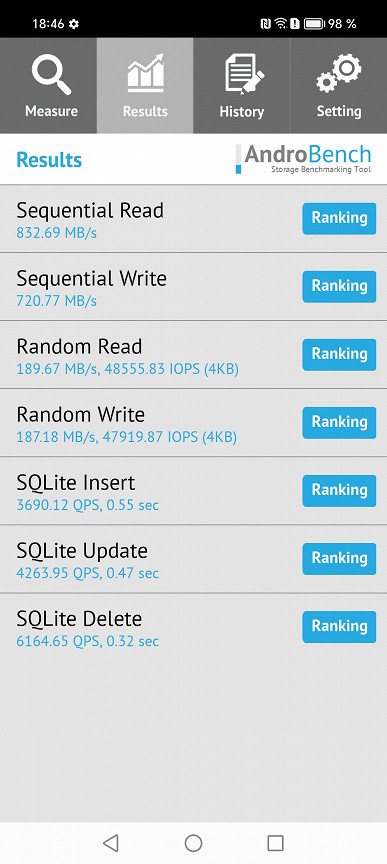
Heat
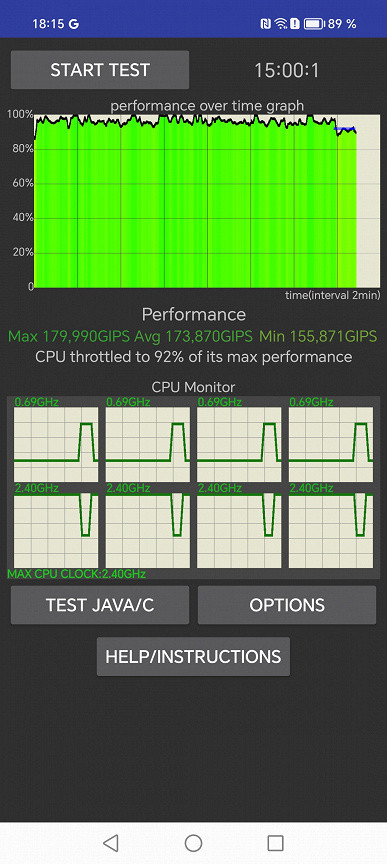
Battery life
The Honor X8b smartphone has a battery with a not very large capacity of 4500 mAh, but the battery life of the smartphone is excellent.
Testing has traditionally been carried out at the usual level of power consumption without using power saving functions, although the device has them. Test conditions: the minimum comfortable brightness level was set (approximately 100 cd/m²). Tests: continuous reading in the Moon+ Reader program (with a standard, light theme); continuous viewing of video in HD quality (720p) via your home Wi-Fi network; Injustice 2 game with automatic graphics settings.
| Battery capacity | Reading mode | Video mode | 3D Game Mode | |
|---|---|---|---|---|
| Honor X8b | 4500 mAh | 23:00 | 20:00 | 8:00 am |
| Vivo V29e 5G | 5000 mAh | 21:00 | 18:30 | 8:00 am |
| Tecno Pova 5 Free Fire | 6000 mAh | 22:30 | 16:30 | 7:30 a.m. |
| Tecno Pova 5 Pro | 5000 mAh | 20:00 | 13:30 | 7:00 am |
| Tecno Camon 20 Premier 5G | 5000 mAh | 25:00 | 19:00 | 7:00 am |
| Vivo V27 | 4600 mAh | 25:00 | 19:00 | 7:00 am |
| Poco X5 Pro 5G | 5000 mAh | 18:00 | 20:00 | 7:00 am |
| Realme 10 Pro+ 5G | 5000 mAh | 19:00 | 18:00 | 5:00 a.m. |
| Xiaomi 12T | 5000 mAh | 19:00 | 16:00 | 6:00 am |
All these are the maximum possible figures obtained under “ideal” conditions, including without installed SIM cards. Any changes in the operating scenario will most likely lead to worse results.
Using the included 35 W mains charger, the smartphone is fully charged within 1 hour and 15 minutes. Wireless charging is not supported.
Bottom line
The Honor X8b smartphone offers an excellent flicker-free AMOLED screen, a stylish body with a thickness of 6.8 mm and a weight of 166 g, as well as a budget processor, despite a relatively weak 108 megapixel camera. Its outstanding battery life, despite its modest battery capacity, makes it an attractive choice at a reasonable price.



